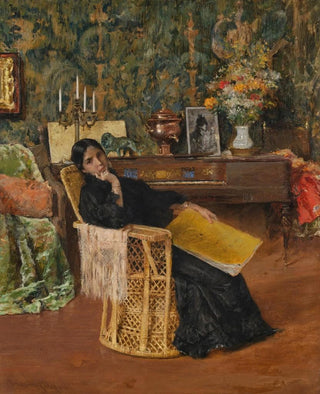Art print | In the studio - William Merritt Chase


View from behind

Frame (optional)
In the world of art, some works manage to capture the very essence of creativity and artistic intimacy. "In the studio - William Merritt Chase" is a perfect example. This painting evokes not only a workspace but also a sanctuary where the artist engages in an endless exploration of light, colors, and shapes. By entering this space, the viewer is invited to share a privileged moment with the artist, to feel their inspiration, and to understand the challenges and joys that creation entails. The piece unfolds like an open window into the artistic process, revealing the thoughts and emotions that inhabit the artist at the moment of its creation.
Style and uniqueness of the work
The uniqueness of "In the studio" lies in Chase's mastery of playing with light and shadow, a central element of his Impressionist style. This artwork stands out for its bold use of color and the way it captures subtle nuances of natural light. The objects in the studio, from canvases to tools, are rendered with a precision that reflects the artist's keen eye. Every element, whether a simple brush or an in-progress canvas, is imbued with a vibrant, almost palpable atmosphere. Chase manages to create an ambiance where time seems suspended, allowing the viewer to feel a deep connection with the piece. The composition itself, with its flowing lines and harmonious arrangement, invites prolonged contemplation, revealing new facets with each glance.
The artist and his influence
William Merritt Chase, an iconic figure of American Impressionism, left his mark on his era with his innovative approach to painting. Born at the end of the 19th century, he dedicated his life to exploring pictorial techniques and teaching art. Chase influenced many artists of his generation, notably through his penchant for depicting everyday life and intimate scenes. His studio, a true laboratory of creation, was a place where he relentlessly experimented, seeking to capture the ephemeral. His legacy endures today, still inspiring generations of artists to

Matte finish

View from behind

Frame (optional)
In the world of art, some works manage to capture the very essence of creativity and artistic intimacy. "In the studio - William Merritt Chase" is a perfect example. This painting evokes not only a workspace but also a sanctuary where the artist engages in an endless exploration of light, colors, and shapes. By entering this space, the viewer is invited to share a privileged moment with the artist, to feel their inspiration, and to understand the challenges and joys that creation entails. The piece unfolds like an open window into the artistic process, revealing the thoughts and emotions that inhabit the artist at the moment of its creation.
Style and uniqueness of the work
The uniqueness of "In the studio" lies in Chase's mastery of playing with light and shadow, a central element of his Impressionist style. This artwork stands out for its bold use of color and the way it captures subtle nuances of natural light. The objects in the studio, from canvases to tools, are rendered with a precision that reflects the artist's keen eye. Every element, whether a simple brush or an in-progress canvas, is imbued with a vibrant, almost palpable atmosphere. Chase manages to create an ambiance where time seems suspended, allowing the viewer to feel a deep connection with the piece. The composition itself, with its flowing lines and harmonious arrangement, invites prolonged contemplation, revealing new facets with each glance.
The artist and his influence
William Merritt Chase, an iconic figure of American Impressionism, left his mark on his era with his innovative approach to painting. Born at the end of the 19th century, he dedicated his life to exploring pictorial techniques and teaching art. Chase influenced many artists of his generation, notably through his penchant for depicting everyday life and intimate scenes. His studio, a true laboratory of creation, was a place where he relentlessly experimented, seeking to capture the ephemeral. His legacy endures today, still inspiring generations of artists to






